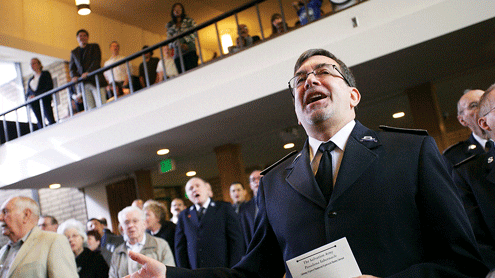Robert Docter, Editor-In-Chief
It’s October. Baseball’s World Series once again lights up the headlines as the fans and combatants compete for glory or grieve in defeat. It signals the final end to a long exposure, daily spanning spring, summer and fall. Soon the stadium lights will darken, and the sounds of the crowd and the crack of the bat will fade, leaving an empty stadium and an empty space within me. The rich odor of beautifully groomed, recently cut, emerald grass combined with the floating fragrance of freshly popped corn will disappear for a season. The heroes of the evening retire until spring.
Baseball plays an orderly game. Its precision strikes awe within us as a player spears a sharply hit ground ball, whirls and throws across the diamond, narrowly beating a batter to the bag as the man in the black suit standing nearby simply raises one arm. His nonchalance belies the emotions surrounding the event. The player returns the ball to the pitcher who performs his regular rituals preparatory to pitching.
Every element of baseball requires perfection as careers and dreams live or die by inches. Even the groundskeeper achieves perfection.
Baseball is a perfect game.
The season ends with the completion of the World Series.
Football has arrived. Its troops marching up and down, kicking missiles straight through the arms of tall goal posts, connecting on long passes, daring, twisting runs bringing people to their feet, players getting hit, getting hurt, getting helped off the field while the winds of autumn whip across the gridiron. It’s all there: cheering crowds led by dancing girls, a white horse racing around the field of play with a costumed warrior on its back waving a gleaming sword, bands blaring and future millionaires showing their wares. I wonder, did the men of Troy race to the fray on the backs of white stallions, or was their mount made of wood in whose belly lay subterfuge?
Football is an exciting game.
The season ends with the Super Bowl.
In the United States, football and baseball attract more spectators and generate the most income of any sport.
We love our sports. Television brings us much closer to the action and always gives us a second look. It brings us all the new expressions, all the new rules. We bring our feelings to the tube: exhilaration and despair, excitement and boredom, relief and suffering, anger and joy. We are more visibly aroused viewing sports than with any other telecast. We yell at referees, criticize inept play, cheer scoring performance, and talk with anyone about the action whether they listen or not.
Sport impacts us.
The important question, however, is “how?” Different sports present different group cultures. Membership in these groups may serve as powerful reference groups. People take on the characteristics of those they choose as models and with whom they associate. So, what characteristics, what behaviors on the playing field leap into our identity in the stands or in front of our big-screen plasma?
We become immersed in the ethic of the performers. All too often we adopt the game’s culture: the values, attitudes, beliefs as presented in the player’s behavior.
Two basic values differ significantly depending on national origin. They are individualism and connectivity. The teamwork of sport reflects the possibility of connectivity, but our individualistic values trump it quickly and require us to identify a star–an individual who will lead the team–the big hitter and winning pitcher in baseball and the quarterback and running back in football. A sport without a star is not a major sport in the U.S.
The sport, then, both reflects the common culture and, in a powerful way, models certain values, attitudes and beliefs in behavior on the playing field.
In New Zealand, a popular website titled “Anarchia” has begun questioning whether rugby players who demonstrate “destructive masculinity” encourage “similar aggression by spectators.” They also note “a general disrespect for women.”
In the U.S, there have been an increasing number of physical confrontations in the stands during and following games.
Fans reveal their team loyalty with attire even when visiting a game in a rival city. An incident in the Dodger Stadium parking lot last year following a Giants game caused serious and possibly permanent life-changing injury to a Giants fan. Oakland Raiders fans have long displayed such fan behavior and even have a section in the stadium where such conduct occurs.
Alcohol at sporting events contributes heavily to initiating the violence.
Team managements, aware of a growing trend, have limited alcohol sales late in the game and have increased the amount of security both in the stadium and in the parking lots. They have not–and probably cannot–modify a mistaken interpretation of fan loyalty. Nor can they change the actual violent nature of games like football, soccer, rugby or basketball. They could change some rules concerning piling on and chest-beating following a touchdown.
We need to recognize the nature of the violence on the field and resist the transfer of these feelings to ourselves.











